What goes on in the mind of the social media user? I’ve often wondered.
I look at a social account and think about the psychology behind the actions we’re all hoping for, as marketers. Why do people follow? Why do they share?
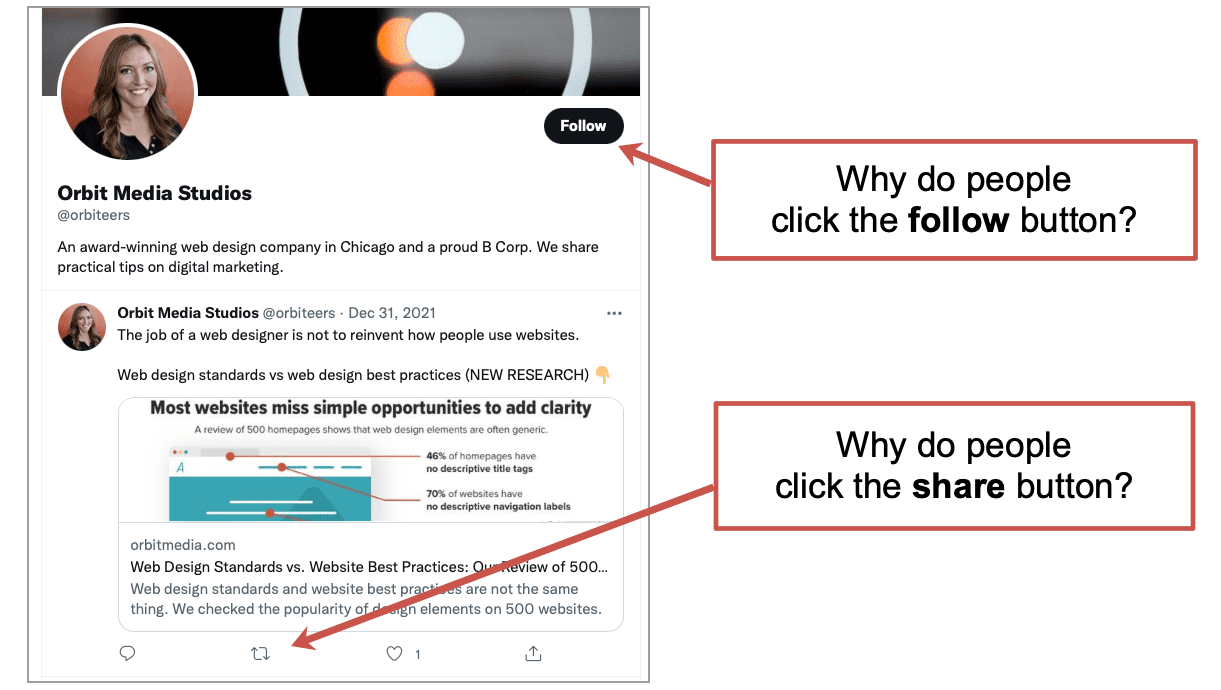
So when QuestionPro offered to collaborate on a quick survey, I jumped at the chance. The next day I had my questions written. The following day I had the data.
The idea is to learn about the psychology of social media interactions and understand the WHY behind certain social media activity. Why do they click? And do their reasons align with what marketers think? Or are marketers missing something?
Our purpose is to provide general answers to some big and important questions.
- Why do people follow social media accounts?
- Why do people share content?
- Where are people messaging each other?
- How do people feel about ads on social media?
- Do people trust company messages on social media?
So here are the five big takeaways and results of a quick, informal survey into the psychology of social media users, with a brief analysis and recommended actions for each datapoint. More about the methodology and dataset at the end.
1. Social media users don’t follow because they want content
Why do people follow others on social media?
There are a lot of reasons why people follow. We asked this question and gave respondents four possible answers and allowed them to choose just one, the primary reason.
Then we asked a separate group of marketers: Why do social media users follow other accounts? The goal is to learn if there is a difference. There is.
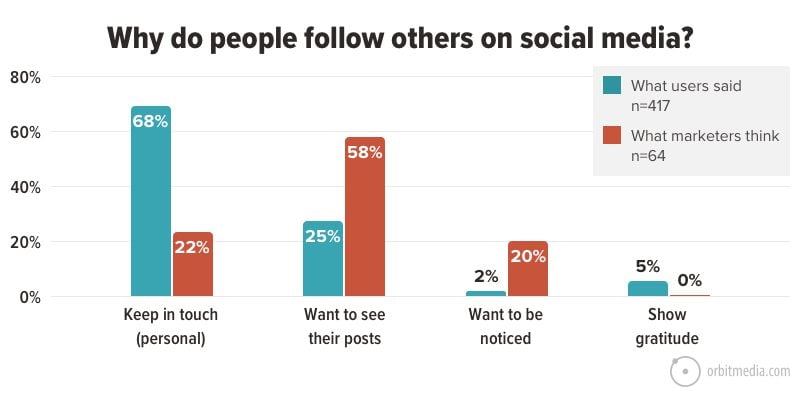
Social media users follow because they want to keep in touch. They’re forming social connections and expecting personal interactions. Users are here for two-way communication, not mainly following as a way to sign up to see posts.
But marketers think that following an account is primarily about getting posts and content. Most marketers see social media as one-way communication. A follow is a “soft subscribe” similar to an email sign up.
The gap is significant but easy to cross with a shift in perspective and approach.
Recommended actions
Remember, content promotion is just one of the three types of social posts. Interact with your network directly in conversation. Schedule time to look at their feeds, respond to their posts, engage in those little interactions.
Social media is more than just a dumping ground for links. Clint Mally knows this and he knows how to work a room. He sums it up beautifully here:
 |
Clint Mally ClintMally.com“We have to remember that all the same social norms of in-person networking are connected to social media. You wouldn’t get someone’s business card in hopes that you could see their content. You get it to connect with them and form some sort of partnership. It’s important to remember that people on social media were called “friends” well before they were called “followers.” |
2. Sharing really is about the content, not the marketing
Why do people share content on social media?
Again, there are a lot of possible reasons. We gave just three options and allowed the respondent to choose just one. Then we asked marketers why they think social media users share. Again, there are big differences.
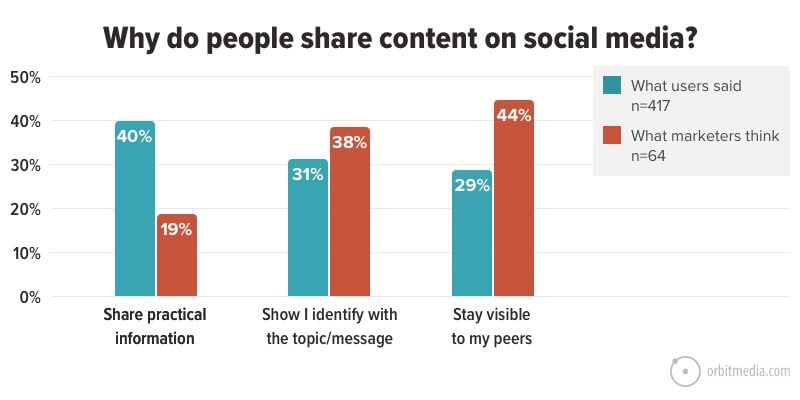
The typical social media user wants to be useful to their network (share practical information) but they aren’t necessarily networking (stay visible to peers). But marketers seem to believe the opposite: that social media is more about visibility and less about utility.
 |
Stephanie Baiocchi Impact+“I think it’s hilarious that marketers think individuals share content to stay “visible.” That’s what marketers, sales pros, and thought leaders do. It’s not surprising though, since there’s typically a huge disconnect between what marketers think their audience does and what they actually do. The truth is any of these could be true depending on your audience. The key is knowing who your audience is and appealing to their behavior.“ |
Both users and marketers are highly aware of the tribal nature of social media. A lot of interactions on social media are intended to simply show alignment with a group or idea. Social media users use sharing to publicly send signals about identity and ideology.
Recommended actions
Focus on quality, as always. But also keep in mind that some types of content are always going to be shared more. Pulling a page from Jonah Berger’s book Contagious, these are the topics that have high practical value or topics that trigger high-arousal emotions.
Got a strong, counter-narrative opinion? Publish it and you’ll see for yourself.
3. Most sharing happens in private networks
Most sharing is not done through public posts. Most messages are private. We all share content and messages through non-social channels. Marketers call this kind of private sharing “dark social” and it’s frustrating because it’s impossible to track. Of course, the average social media user doesn’t care if you can track this activity.
Here’s what US-based social media users are using for private messaging.
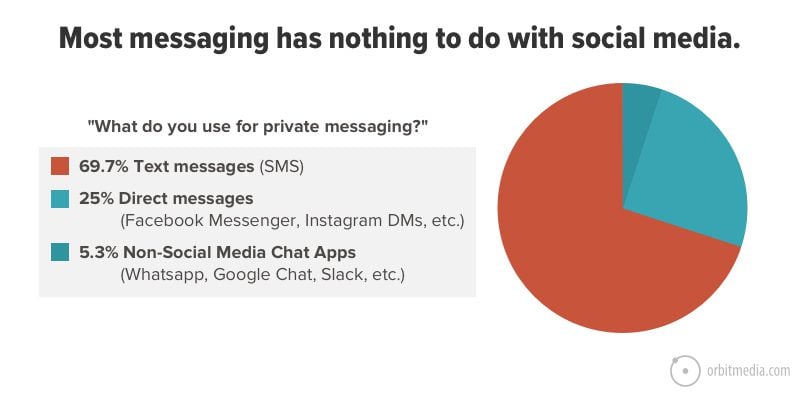
Recommended actions
Accept the fact that your social media metrics aren’t a complete picture.
We highly recommend you use this guide for tracking social media traffic, but accept that many types of sharing are invisible to the marketer. Some of your “direct traffic” includes visitors who got a link (without campaign tracking code) in a text message, app, email program or other non-browser sources of traffic. That’s reality and it’s fine.
4. Most people believe that social networks are spying on them
You may have had this feeling yourself. You have an in-person conversation with a friend, then the next day, you see an ad related to that topic. It’s creepy. Were they listening? My phone’s microphone must be on…
Social targeting is so accurate people believe that the social networks are literally listening in to their conversations. This isn’t an outside case from a minority of uneducated users. Most users have this feeling at some point.
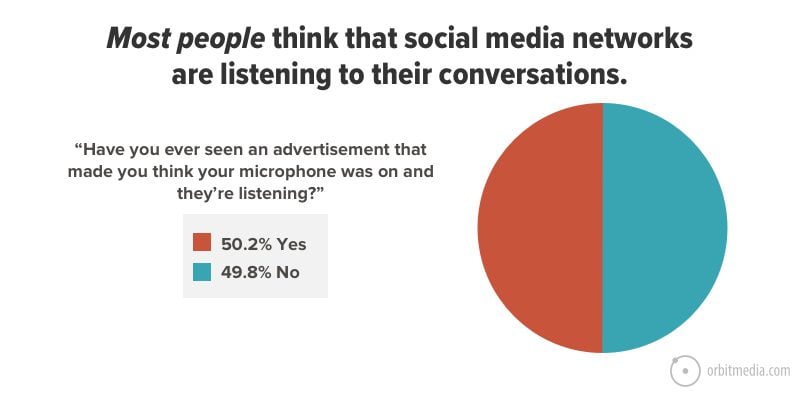
A similar study by Digital Third Coast found that 60% of Americans think their phones are listening to their conversations.
Of course, it isn’t true. Your microphone isn’t on and they aren’t scanning the audio of your conversations. But the effectiveness of paid social targeting is uncanny. How do they do it? I asked social advertising expert, Chris Madden, from Matchnode.
The reason is about your phone’s location services, not the microphone.
 |
Chris Madden, Founder Matchnode“I, as an owner of a social ad agency, have had the same experience of feeling like the ad platforms are listening to me. For example, I’m out to dinner with a friend who I see a few times per year, they mention a company or product that I am unfamiliar with, and the next day I see an Instagram ad for that product. The scary overlords were listening!! This has nothing to do with the mics on our phone and much more to do with our phone’s precise geo-location capabilities. Since most of us leave GPS, wifi, and other location signals on, when my friend and I are sitting at the restaurant for two hours, Facebook and Google “know” that we are together. Facebook’s Machine Learning has also dialed in on some classic marketing truisms: word of mouth is powerful and we tend to like what our friends like. So, after I’ve been together with my friend, Facebook shows me ads for products that my friend likes! Most of these products didn’t come up in our conversation, so those ads don’t stand out. But when that one company we discussed comes up…THEY WERE LISTENING TO US! Less conspiracy and more marketing 101 reflected through our current technology…“ |
Recommended actions
We have two perspectives on this:
- For users: Delete Facebook from your phone. Your mic isn’t on, but it’s still a creepy website. And a huge timesuck. The more boring you make your phone, the happier and more productive you’ll be.
- For marketers: Consider paid social as a marketing channel. It is a highly effective channel for both visibility and conversion, depending on the offer. The targeting is so amazingly accurate that your audience will assume their privacy is being violated …but they’ll click anyway.
Our survey asked social media users if they have engaged with ads. The numbers are high. 44% of respondents report clicking on ads and 27% report spending money on things they saw in a social media ad.
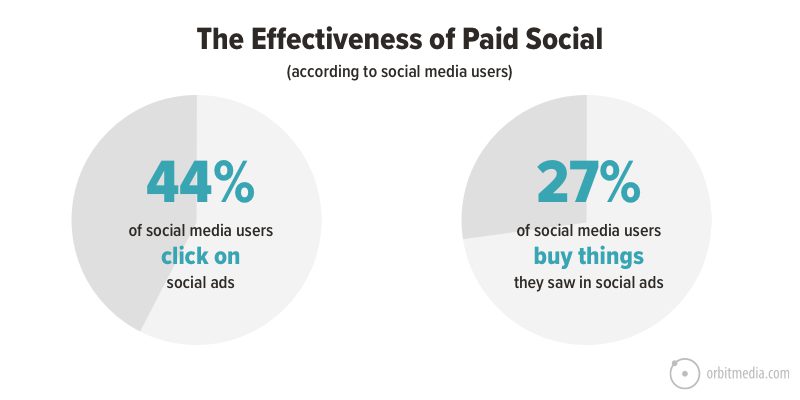
5. People generally don’t trust companies on social media
Despite the high engagement with ads, social media users are generally very skeptical of businesses on social media.
71% said ‘no’ when asked if they trust the information companies are posting on social media. This may be a general response to years of clickbait headlines and more general skepticism of marketing. After all, the users are here to interact and the marketers are here to promote. They may see us as invaders in their space.
But marketers may not be aware of this sentiment. 80% of marketers say ‘yes’ to the question ‘Do social media users generally trust the information that companies post on social media?’
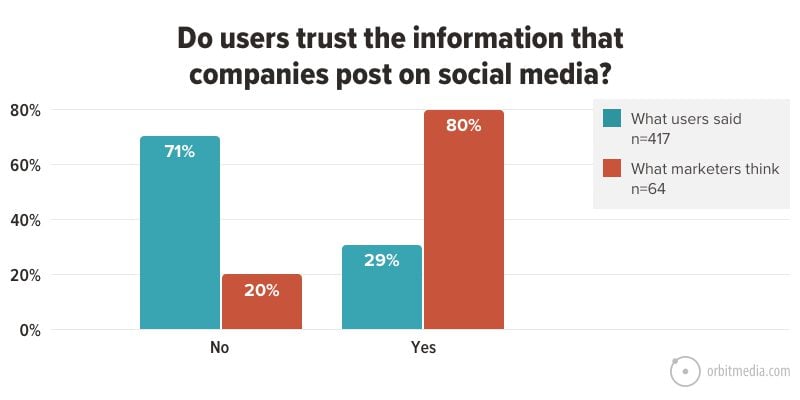
This adds to the misunderstanding we saw in the previous answers.
- Social media marketers: “My followers are on social media to get marketing content and they trust it.”
- Social media users: “I’m not here to get your articles and I don’t trust company content anyway”
Ironically, trust in companies is actually higher than trust in government or media, according to a much more rigorous survey, the Edelman Trust Barometer. Globally, trust in businesses is up slightly and remains higher than trust in other types of organizations.
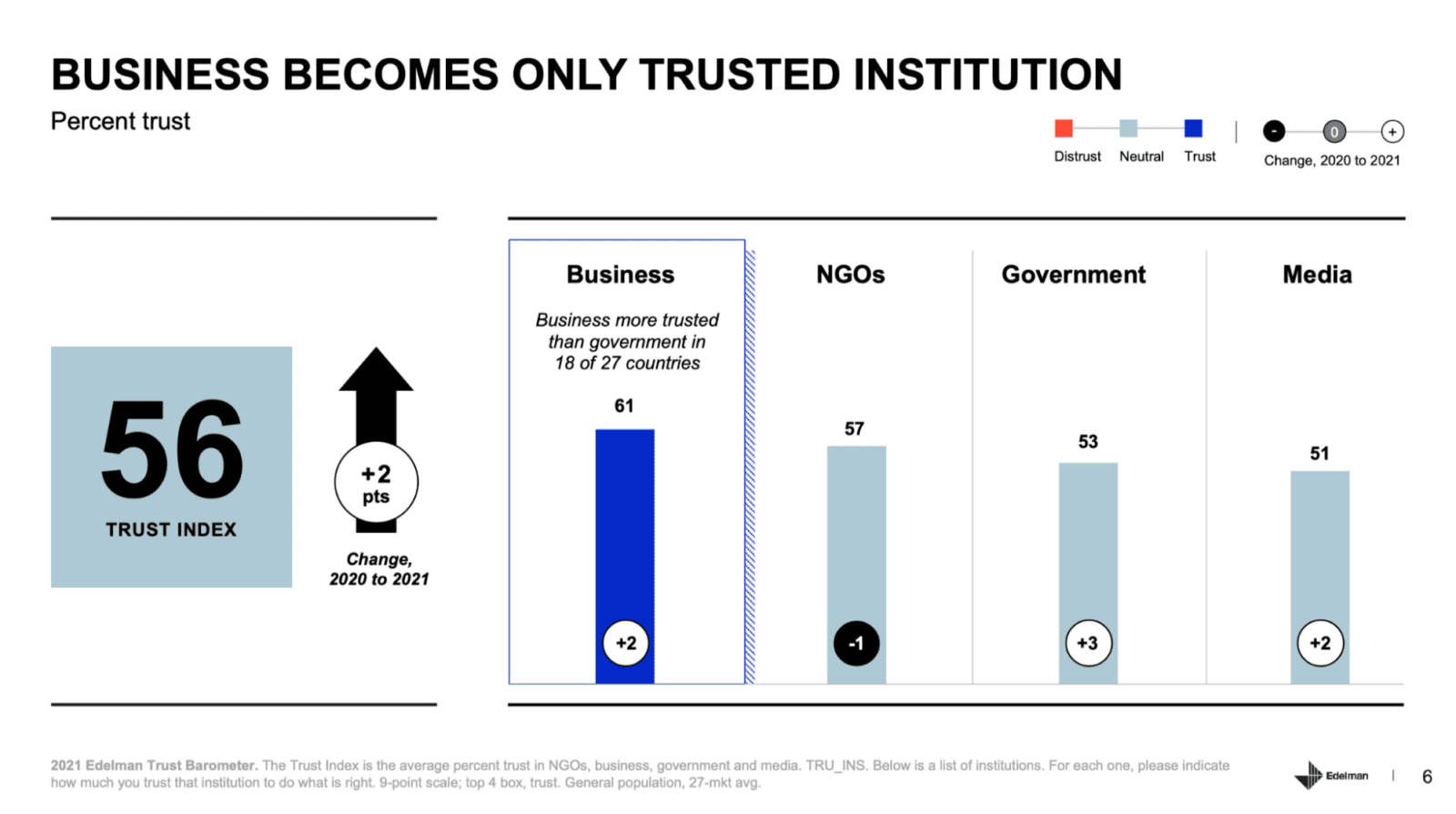
Let’s ask a communications pro for a second opinion. Here’s Gini Dietrich reminding us to think beyond this datapoint and more broadly about marketing and trust.
 |
Gini Dietrich Spinsucks.com“It’s interesting that social media users say they don’t trust what companies post on social media when the data proves otherwise. It’s not just the Edelman Trust Barometer that proves that sentiment wrong, either. Think about your own online behavior, as a consumer. If you’re thinking about making a purchase, what’s one of the first things you do? We start to look all over the internet for information about said purchase. We look at the website of the manufacturer and you look at that of their competitors. We may not totally believe what’s on the website of the manufacturer because we instinctively think they’re only posting positive things. So we look at review sites, we look at competition, and we ask our friends on social media. Pretty soon, we’re getting ads for said product in our newsfeeds and we see the good, the bad, and the ugly. We get testimonials, we see before and after photos, and sometimes influencers post things we see, too. All of this leads to us making a decision. So, while social media users may not trust what companies post, all of the marketing they do to support a purchase decision (organic and paid social, influencer marketing, news stories, testimonials, and more) lead to a decision.“ |
Recommended actions
If everything you post in social media is self-promotional or thinly disguised advertising, then you’re playing into the expectation that businesses aren’t good social media citizens. You’re boring at best and corrosive at worst.
What to do instead? For starters, don’t lie. Beyond that, here are some social strategies that can build trust:
- Be transparent. Show yourselves. Keep it real. Post questions. Share your challenges. Don’t make every post self-promotional.
- Share practical things that your audience can actually use.
- Set expectations about what they’ll get if they follow. Make your bio more than an “about us” summary. Make it a call to action that summarizes what you post. Make a promise and then live up to it.
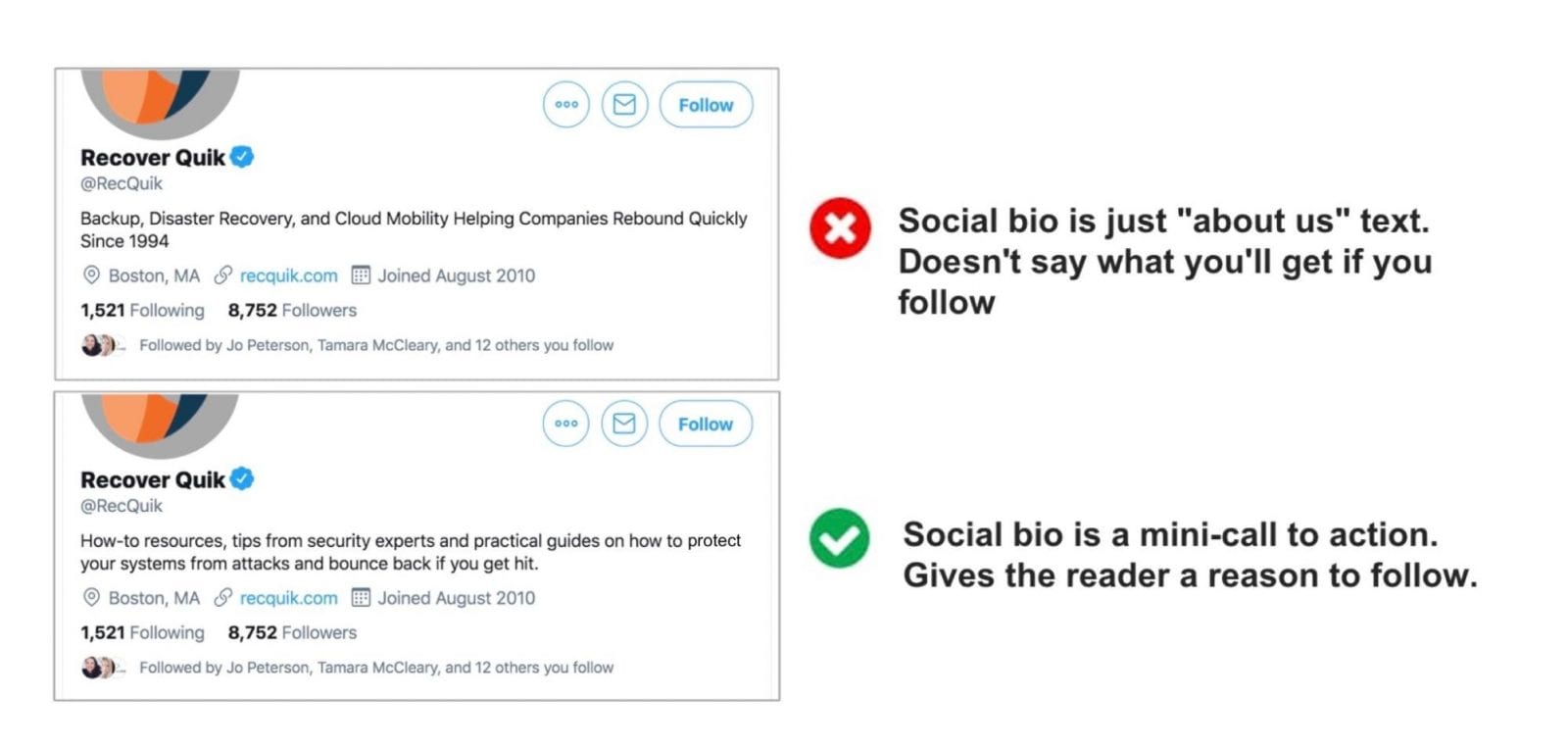
Source: How to Write a Content Marketing Mission Statement
About the data and methodology
Some social media research is behavioral, based on analysis of social metrics.
This social media research is attitudinal, based on a survey of social media users.
The original survey of social media users was a collaboration with QuestionPro. We wrote the questions. They built the sample from a “gen pop” (general population) audience. It was conducted in April of 2022.
The 412 respondents reported being active on a huge range of social networks. Facebook/Instagram was more than 50%, followed by Twitter, TikTok and YouTube, but also other networks such as Twitch, Gab, Discord and Snapchat.
The survey of 64 social media marketers was completed concurrently by users from our LinkedIn network, which is mostly US-based marketers.
Special thanks to Ivana Taylor of DIY Marketers for the introduction that led to this mini-research project!




